In May of this year the BBC announced the launch of a “new brand“ called ‘BBC Verify’:
THE BBC ANNOUNCES YET ANOTHER ANTI-DISINFORMATION PROJECT
In October, BBC News chief executive Deborah Turness promised more investment in that “fact-checking and transparency brand” at an event with potential advertisers.
“Turness said BBC Verify was “really having an impact. It’s very early days. I don’t think any of us expected it to take off quite the way it has. And you’re going to see us pouring in more investments both here and around the world”.”
When the Hamas terrorist organisation launched its unprecedented invasion of Israeli territory and rampage of massacres, torture and kidnappings on October 7th, BBC Verify produced several items promoted as providing audiences with “an accurate picture of what has been unfolding”.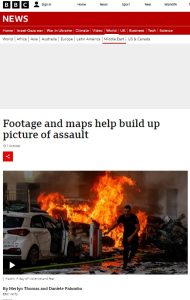
The first of those items appeared on October 7th under the headline ‘Footage and maps help build up picture of assault’ and is credited to Merlyn Thomas and Daniele Palumbo.
In the opening paragraphs readers discover that in fact, what they are going to be shown is at the BBC’s discretion. [emphasis added]
“Footage from Israel and Gaza has been surfacing on social media, much of it disturbing and violent. There are images of Israeli hostages being paraded on streets by militants in Gaza, while others show high-rise buildings being reduced to rubble.
BBC Verify has been looking at all this material to build up an accurate picture of what has been unfolding. Some of the content we have seen is extremely disturbing so we have chosen not to show it.”
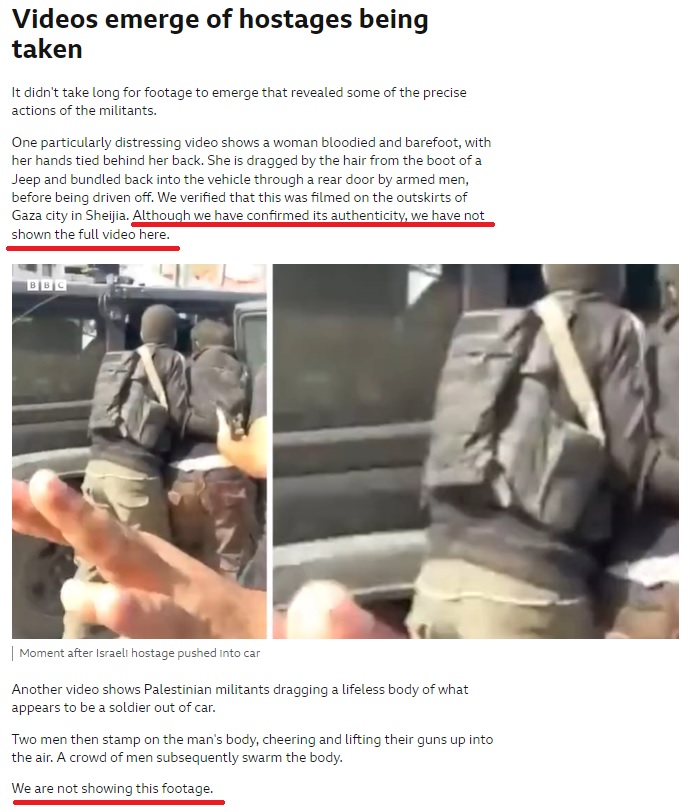
Throughout that report the people who carried out the atrocities that the BBC finds too shocking to show its audiences are referred to as “militants”, “Hamas militants”, “Palestinian militants” or “armed men”.
Also on October 7th, BBC Verify put out a video presented by Jon Donnison titled ‘Watch: How Hamas’ shock attack on Israel unfolded’.
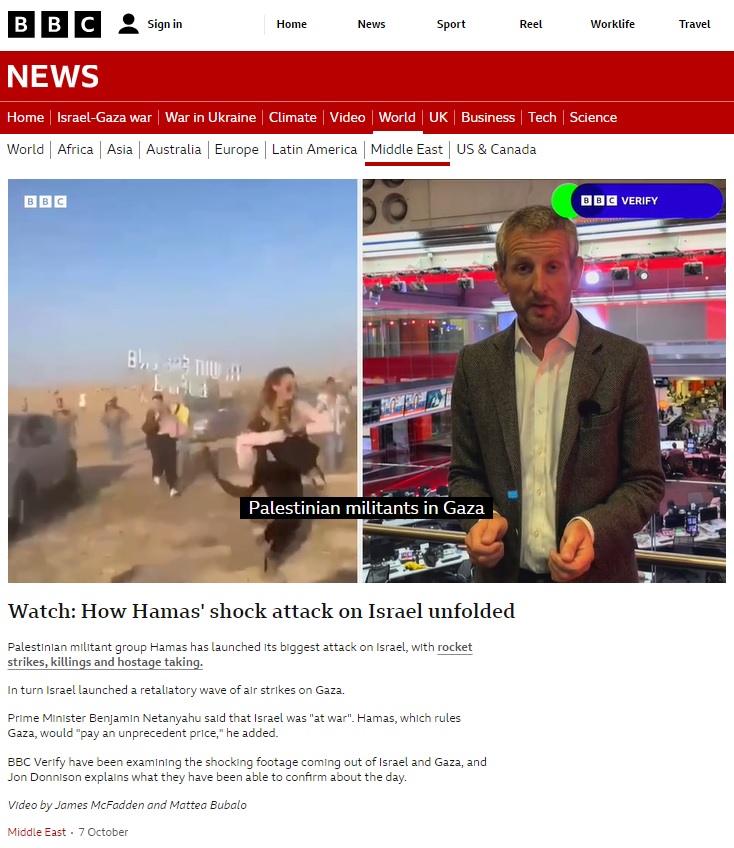
That video includes the same highly edited footage of the bloodied female hostage in a jeep and likewise refers to the perpetrators of the attacks as “Palestinian militants” and “militants”.
The BBC Guidance on ‘Stills, photographs and images’ includes the following under the sub-heading ‘Harm and Offence’:
“Where our content relates to a subject that is potentially shocking or offensive, using a still image rather than moving footage may reduce the likelihood of causing offence.
However, images should not normally feature the following:
Graphic violence, torture, or any extreme violent behaviour.”
Clearly those instructions present a dilemma to journalists covering exactly such events. They also raise questions concerning the right of BBC audiences not to be shocked or offended versus their right to have the story reported accurately and in a way which does not downplay the acts of the perpetrators, thereby failing to fully inform. One must surely also take into account the right of the victims (and their families) of horrific violence such as murder, rape, torture, burning people alive and beheadings to have their story told accurately and without omission.
On October 8th BBC Verify put out another report titled ‘How Hamas staged Israel lightning assault no-one thought possible’. Credited to Sean Seddon and Daniele Palumbo, that report also describes the terrorists who carried out the unprecedented attacks as “militants” and “Hamas fighters”.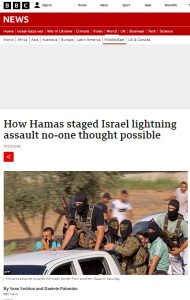
Readers are told only of “rudimentary rockets” but not that Hamas also possesses more advanced missiles. Neither are readers informed that “this tactic” – i.e. the indiscriminate targeting of civilians with missiles – is a war crime.
“At around 06:30 local time, the rockets began to fly.
The Islamist militant organisation – which controls Gaza and is designated as a terrorist group in the UK and elsewhere around the world – uses this tactic frequently.
The rudimentary rockets often struggle to evade Israel’s advanced Iron Dome missile defence system – but thousands were fired in a short space of time to overwhelm it.”
Readers are told that:
“Although Israel pulled its troops and settlers out of Gaza in 2005, it still controls its airspace, shared border and shoreline.”
Seddon and Palumbo neglect to inform readers of the November 2005 Agreement on Movement and Access between Israel and the Palestinian Authority and the fact that it included plans for a seaport and an airport which had to be shelved when the terrorist organisation Hamas staged a violent coup in the Gaza Strip in 2007 and subsequently increased its terror attacks against Israelis.
Readers are also told that:
“Gaza has seven official crossings – six are controlled by Israel, one into Egypt is controlled by Cairo.”
In fact there are currently three crossings into the Gaza Strip: Rafah (under Egyptian control) and Erez and Kerem Shalom under Israeli control. The four other previously existing crossings have not functioned for well over a decade, in large part due to Palestinian violence. Kissufim was closed in 2005 after Israel’s withdrawal from the Gaza Strip, Sufa was closed in 2008, Nahal Oz was closed in 2010 and Karni was closed in 2011.
Under the sub-heading ‘Attacks reach deep into Israeli territory’ readers find the following:
“Around a dozen armed fighters were seen fanning out through the empty streets of Ashkelon, just to the north of the Erez crossing which had just been stormed.”
Notably, at the end of the report it published the previous day, BBC Verify had told audiences that:
“There is footage on social media showing armed men patrolling the streets of the Israeli city of Ashkelon. This is likely to be Israeli police or armed forces responding.”
Both those conflicting accounts remain online without clarification.
Readers of BBC Verify’s October 8th report also find the following:
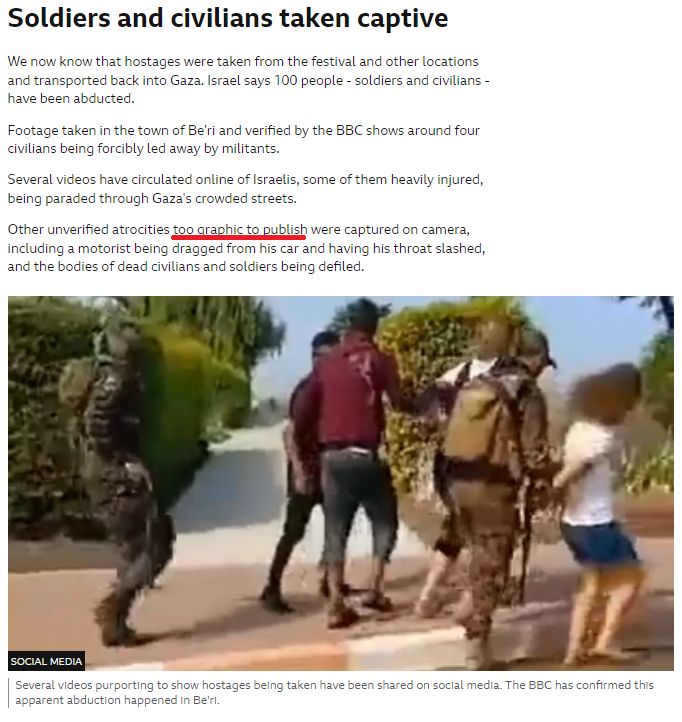
BBC Verify has not updated its report to inform BBC audiences that the four civilians from Kibbutz Be’eri appearing in the “footage…verified by the BBC” were murdered a short time after that footage was filmed.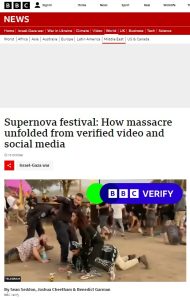
On October 9th the BBC News website published another report by BBC Verify titled ‘Supernova festival: How massacre unfolded from verified video and social media’ and credited to Sean Seddon, Joshua Cheetham and Benedict Garman.
That report opens with a trigger warning:
Warning: This article contains details that some may find distressing
Readers find the following:

In fact, as reported by many other Israeli and foreign media outlets including the Telegraph, the Guardian, the Independent, the New York Post and Kan 11, those “dark wisps” seen in the video were not “smoke” or “plumes left behind by the defensive missiles used by Israeli military to intercept rockets fired from Gaza” but Hamas terrorists arriving at the scene on motorised paragliders.
The BBC’s report has not been updated to include that vital information.
The report refers to the perpetrators of the attack on the music festival as “militants” and “gunmen” throughout. Readers are told that “The festival had become a warzone” despite the fact that, rather than the location being “a region in which a war is being fought” as the word warzone implies, it was actually the site of a pre-planned massacre against overwhelmingly unarmed civilians.
As we see, BBC Verify’s reporting leaves a lot to be desired, particularly in light of its branding as a department set up to “address the growing threat of disinformation” and carry out fact checking.

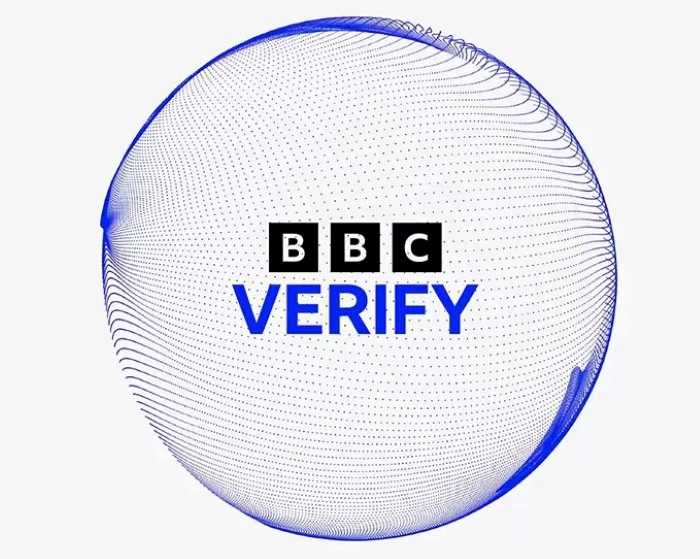




I find it hard to believe that the BBC intranet is not working, or have the promised policy changes not yet been disseminated to the employees yet.? Their continued bias against Jews and Israel is there for all to see #defundthebbc